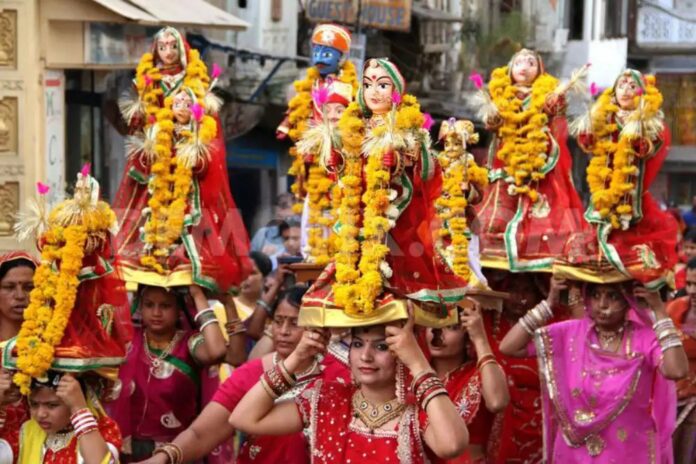Gangaur is a vibrant and joyous festival celebrated predominantly in Rajasthan, India. It holds great significance for married women, who pray for the well-being and longevity of their husbands. This festival beautifully blends religious rituals with social customs, showcasing the rich cultural heritage of Rajasthan.
The word “Gangaur” is derived from two words: ‘Gana’, which represents Lord Shiva, and ‘Gaur’, symbolizing Goddess Parvati (also known as Gauri). The festival mainly honors this divine couple and their eternal bond. It usually falls in the month of Chaitra (March-April), following the festival of Holi, and continues for about 18 days.
Rituals and Traditions
The festival kicks off with women creating clay idols of Gauri (Parvati) and Isar (Shiva), beautifully adorned and painted. Married women, dressed in colorful traditional attire, carry these idols on their heads in a procession. This procession, accompanied by singing and dancing, moves through the streets, culminating at a water body like a river or a lake.
Also Read: ‘When opposition burns their wives’ Indian saris’: Bangladesh PM Hasina
Idol Immersion
Once at the water body, the idols are immersed with reverence. This act symbolizes the departure of Gauri to her husband’s home, marking the end of her visit. The immersion is not just a ritual; it’s an emotional farewell where women pray for marital bliss and conjugal happiness.
Fasting and Prayers
During Gangaur, married and unmarried women observe a strict fast. They abstain from eating food throughout the day and break their fast only after offering prayers to Gauri and Isar. Married women pray for the well-being of their husbands and the prosperity of their families. Unmarried women, on the other hand, seek blessings to find a suitable life partner.
Decorations and Celebrations
Homes are decorated beautifully during Gangaur with colorful rangolis (patterns made with colored powders) adorning the thresholds. Women apply henna (mehndi) on their hands and feet, dressing up in traditional Rajasthani attire like ghagras (skirts) and odhnis (veils). The entire atmosphere resonates with joy and festivity.
Cultural Significance
Gangaur is more than just a religious festival; it’s a celebration of love and marital happiness. It also reflects the agricultural roots of Rajasthan, where communities rejoice in the arrival of spring and pray for good harvests. The festival brings together families and communities, reinforcing social bonds and fostering a sense of togetherness.
Conclusion
In essence, Gangaur is a mesmerizing tapestry of devotion, tradition, and culture. It showcases the deep-rooted beliefs and customs of Rajasthan while celebrating the timeless bond between husband and wife. The festival not only adds a splash of color to the arid landscapes of Rajasthan but also enriches the lives of its people with faith and merriment. Gangaur truly exemplifies the spirit of love, companionship, and enduring marital bliss.







